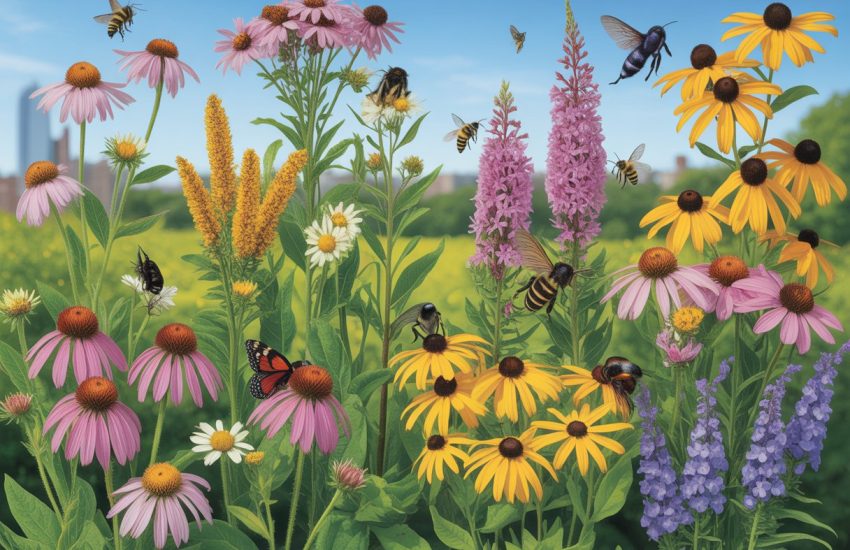How to Pot Succulents: A Step-by-Step Guide
Succulents are a popular choice for indoor and outdoor plants due to their unique appearance and easy maintenance. Potting succulents is a simple process that can be done by anyone with a few basic tools and materials. In this article, we will provide step-by-step instructions on how to pot succulents to ensure they thrive in their new environment.

The first step in potting succulents is to choose a suitable container. Succulents prefer well-draining soil and a pot with drainage holes to prevent water from accumulating and causing root rot. Once a container has been selected, it’s time to prepare the soil. Succulent soil should be a mixture of sand, perlite, and peat moss to promote drainage and aeration.
After preparing the soil, it’s time to plant the succulent. Gently remove the plant from its current container and loosen any tangled roots. Place the succulent in the new pot and fill in the surrounding space with soil, being careful not to bury the stem. Water the succulent sparingly, as succulents store water in their leaves and do not require frequent watering. With these simple steps, anyone can successfully pot succulents and enjoy their beauty for years to come.
Choosing the Right Pot
When it comes to potting succulents, selecting the right pot is crucial for their growth and overall health. Here are some important factors to consider when choosing the right pot for your succulent:
Pot Material
The material of the pot can have a significant impact on the growth of your succulent. Plastic pots are lightweight and durable, making them a popular choice for indoor plants. Ceramic pots, on the other hand, are heavier and can help stabilize top-heavy succulents. Wood and metal pots can also be used, but they may require additional drainage holes.
Drainage Considerations
Succulents require well-draining soil to prevent root rot, which is why choosing a pot with adequate drainage is crucial. Look for pots with drainage holes at the bottom to allow excess water to escape. If you have a pot without drainage holes, you can add a layer of rocks or gravel at the bottom to improve drainage.
Pot Size and Shape
The size and shape of the pot can also impact the growth of your succulent. A pot that is too small can restrict the root growth, while a pot that is too large can lead to overwatering. As a general rule, choose a pot that is about one size larger than the current pot your succulent is in. Additionally, consider the shape of the pot. Wide, shallow pots are ideal for succulents with shallow root systems, while deeper pots are better for succulents with deeper roots.
By considering these factors when choosing a pot for your succulent, you can ensure that your plant has the best chance of thriving.
Essential Supplies
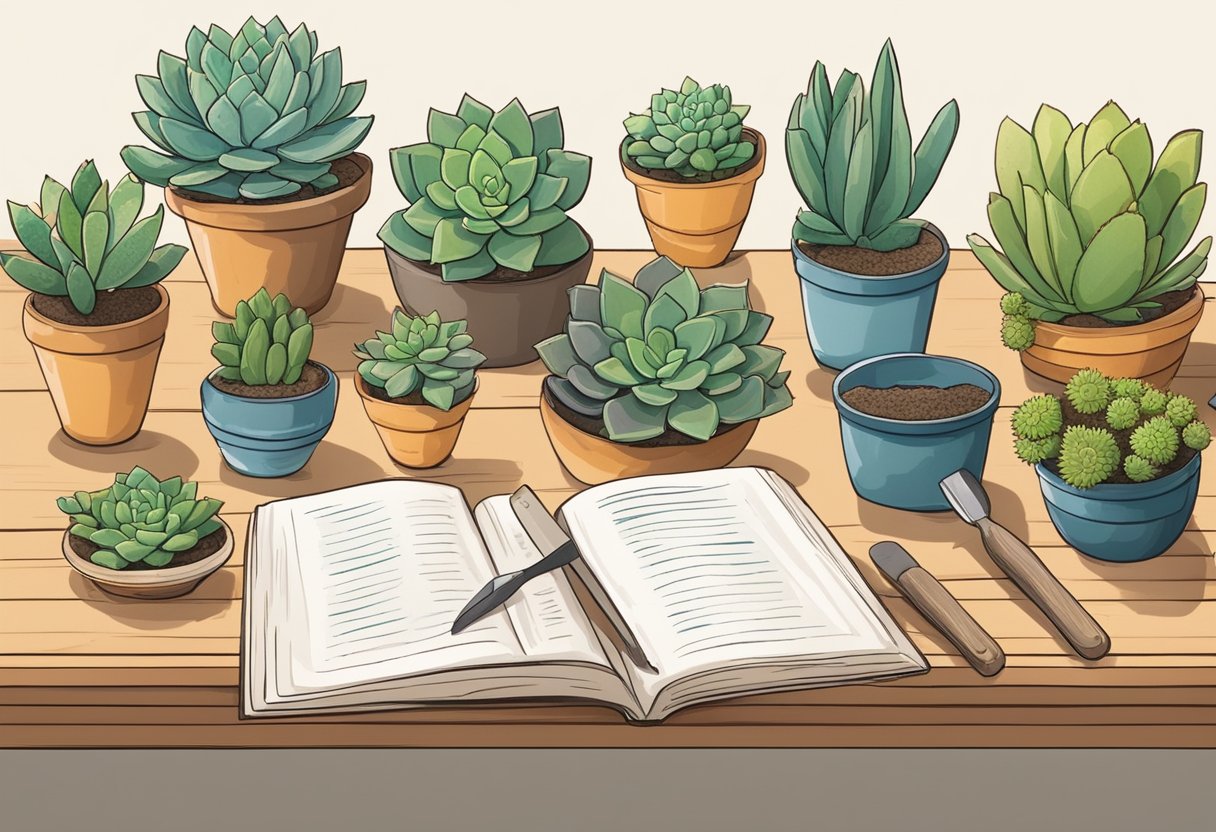
When it comes to potting succulents, having the right supplies is crucial for their growth and health. Here are some essential supplies that are necessary for potting succulents:
Soil Mix
Choosing the right soil mix is important for the growth and health of succulents. Succulents require well-draining soil that allows excess water to drain away quickly, preventing root rot. A good succulent soil mix consists of a combination of soil, perlite, gravel, sand, and pumice. This mixture provides good drainage while also retaining enough moisture for the plants to thrive. Avoid using regular potting soil as it retains too much moisture and can cause root rot.
Tools and Accessories
In addition to the soil mix, there are some tools and accessories that are necessary for potting succulents. These include mesh tape, pebbles, and a pot with drainage holes. Mesh tape is used to cover the drainage holes of the pot to prevent soil from escaping. Pebbles can be used as a decorative top layer on the soil, which also helps to prevent moisture loss. A pot with drainage holes is essential for proper drainage, which helps prevent root rot.
Overall, having the right soil mix and tools and accessories is crucial for the growth and health of succulents. By using a well-draining soil mix and the right tools, succulents can thrive and add beauty to any indoor or outdoor space.
Planting Your Succulents
When it comes to planting succulents, there are a few things to keep in mind to ensure that your plants thrive. Here are some tips for planting your succulents:
Arrangement and Spacing
Before you begin planting, consider the arrangement and spacing of your succulent garden. Succulents come in a variety of shapes and sizes, so it’s important to choose plants that will complement each other and fit well in your container or garden bed.
When arranging your succulents, consider the height and growth habits of each plant. Taller plants should be placed towards the back of the container or garden bed, while shorter plants can be placed towards the front. Be sure to leave enough space between each plant to allow for root growth and airflow.
Layering the Soil
When planting your succulents, it’s important to use well-draining soil. Succulents do not like to sit in wet soil, as this can lead to root rot. To create a well-draining soil mixture, use a combination of potting soil, sand, and perlite.
When planting your succulents, start by adding a layer of soil to the bottom of your container or garden bed. Then, gently remove your succulent from its pot and loosen any tangled roots. Place the succulent in the container and fill in the gaps with soil, making sure to cover the roots completely.
Positioning the Plants
When positioning your succulents, be mindful of the amount of sunlight they will receive. Most succulents prefer bright, indirect sunlight, but some can tolerate full sun or partial shade.
If you’re planting in a container, consider the orientation of the container. Placing the container on a north-facing windowsill will provide bright, indirect sunlight, while placing it on a south-facing windowsill will provide more direct sunlight.
By following these tips for planting your succulents, you can create a beautiful and thriving succulent garden or container garden.
Watering and Drainage

Watering Techniques
Watering succulents can be a tricky task, as too much water can lead to root rot and other issues. It is recommended to water succulents thoroughly and then allow the soil to dry out completely before watering again. This will help prevent overwatering and retain water in the soil for longer periods of time.
One effective watering technique is the “soak and dry” method. This involves thoroughly watering the soil until water drains out of the drainage holes, and then waiting until the soil is completely dry before watering again. It is important to note that watering frequency may vary depending on the climate and environment in which the succulent is located.
Preventing Root Rot
Proper drainage is crucial in preventing root rot in succulents. It is important to ensure that the pot has drainage holes to allow excess water to escape. Additionally, using well-draining soil can help prevent water from accumulating in the soil and causing root rot.
If root rot is suspected, it is important to act quickly to prevent further damage to the plant. This may involve removing the plant from the soil, trimming away any affected roots, and repotting the plant in fresh, well-draining soil.
In summary, proper watering techniques and drainage are essential for the health and well-being of succulents. By following these guidelines, succulent enthusiasts can enjoy a thriving collection of these unique and beautiful plants.
Light and Temperature
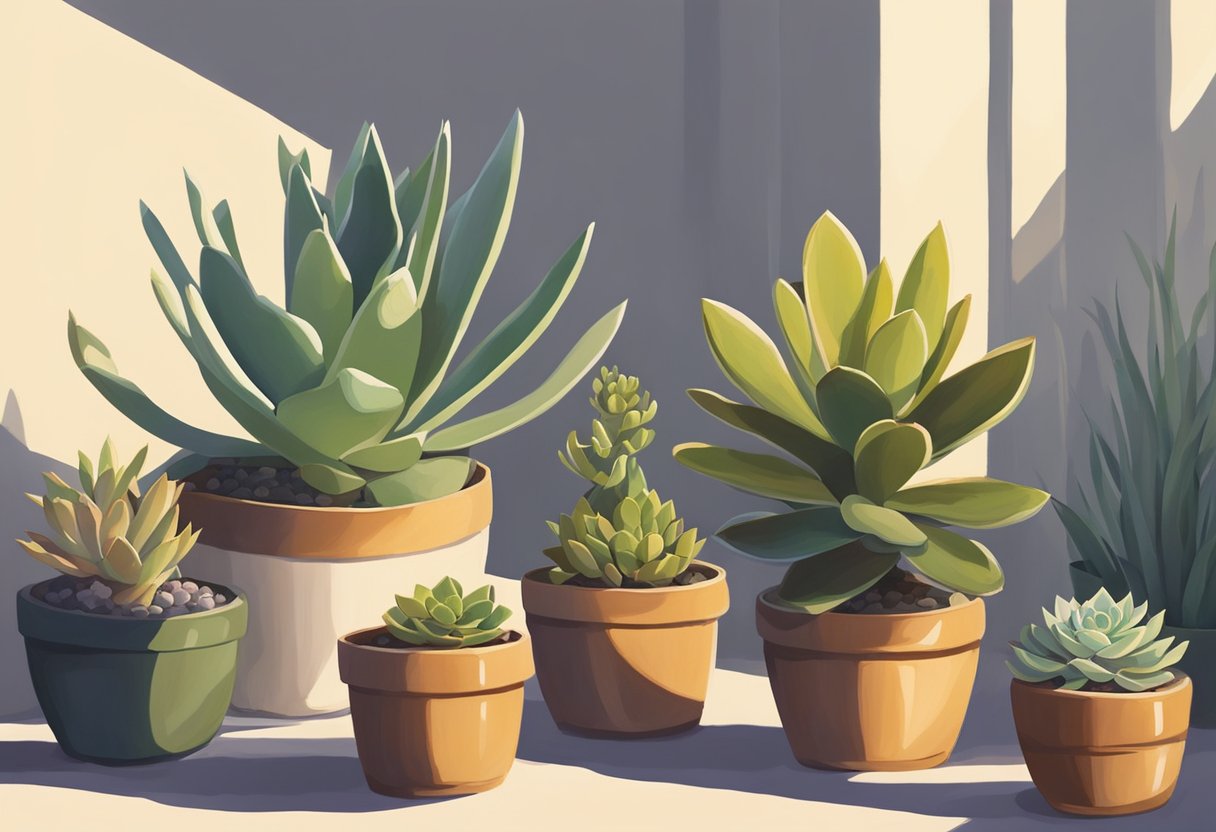
Sunlight Exposure
Succulents require a good amount of light to thrive, but too much direct sunlight can be harmful to them. It is important to find a balance between providing enough light and avoiding scorching the leaves. The amount of sunlight required varies depending on the species, but most succulents prefer bright, indirect light.
If you are growing succulents indoors, place them near a south-facing window that receives plenty of sunlight. If you don’t have a south-facing window, a west or east-facing window can work as well. If the light in your home is limited, consider using grow lights to supplement the natural light.
When growing succulents outdoors, it is important to provide partial shade during the hottest part of the day. This can be achieved by placing them under a tree or a patio cover. If you live in an area with intense sunlight, consider growing your succulents in a location that receives morning sun and afternoon shade.
Climate and Hardiness
Succulents are naturally adapted to hot, arid climates and can tolerate a wide range of temperatures. However, it is important to choose species that are appropriate for your climate and hardiness zone.
Some succulents can tolerate freezing temperatures, while others cannot survive below 50°F (10°C). If you live in an area with cold winters, it is important to choose cold-hardy species and protect them from frost.
On the other hand, if you live in a hot, dry climate, you may need to provide some shade during the hottest part of the day to prevent the leaves from scorching. It is important to research the specific requirements of the species you are growing to ensure their success.
In summary, providing the right amount of light and temperature is crucial for the health of your succulents. By understanding the needs of your plants and making the necessary adjustments, you can create a thriving succulent garden.
Ongoing Care and Maintenance
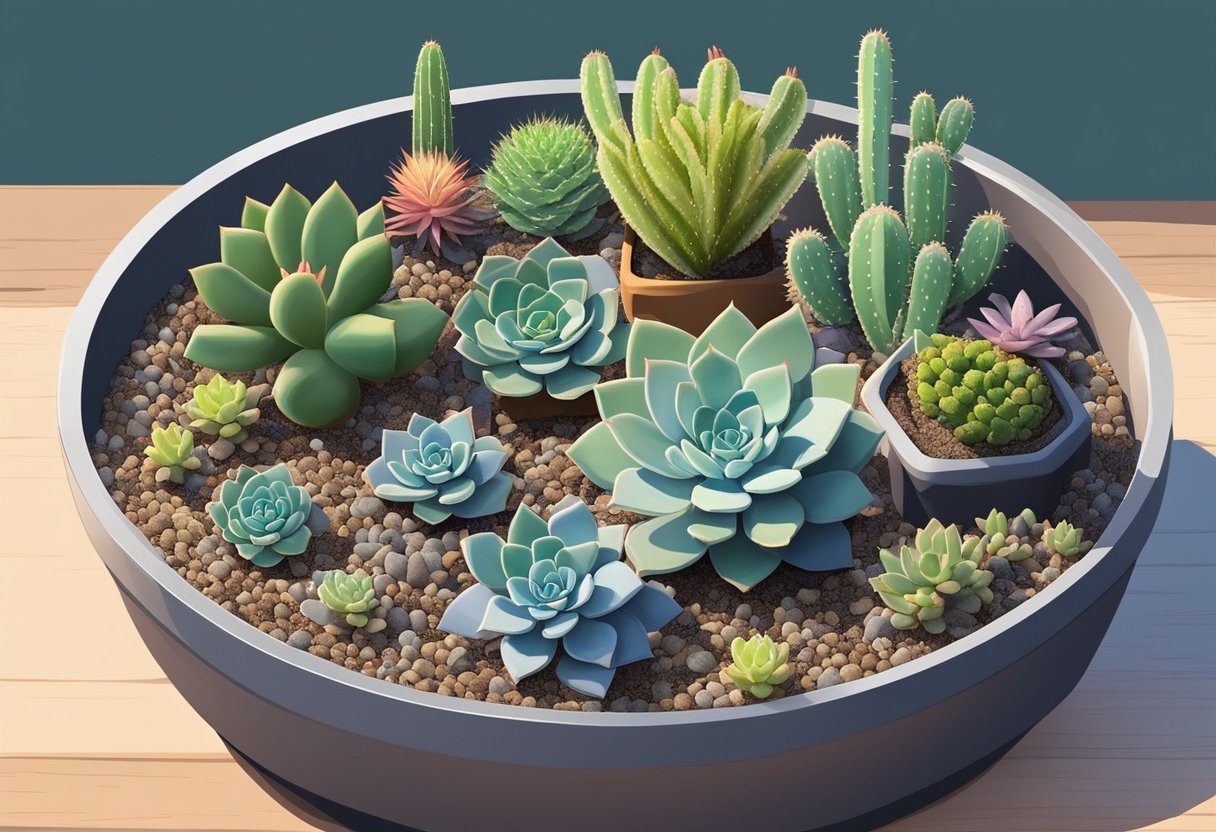
Fertilizing Succulents
Succulents require a balanced diet of nutrients to thrive, and fertilization is an essential part of their ongoing care. However, it’s important not to over-fertilize, as this can lead to root burn and other problems.
When it comes to fertilizing succulents, less is often more. A slow-release fertilizer applied once or twice a year is usually sufficient. Alternatively, you can use a liquid fertilizer diluted to half strength and applied every four to six weeks during the growing season.
Pruning and Propagation
Pruning is an important part of succulent care, as it helps to keep the plants looking neat and tidy. It also encourages the growth of new shoots and can help to prevent disease.
To prune a succulent, simply use a sharp pair of scissors or pruning shears to cut off any dead or damaged leaves or stems. You can also remove any leggy growth to encourage the plant to produce new shoots.
Propagation is another important aspect of succulent care, as it allows you to create new plants from cuttings. To propagate a succulent, simply take a cutting from a healthy plant and allow it to dry out for a few days. Once it has calloused over, you can plant it in a well-draining potting mix and water it sparingly until it begins to root.
Repotting and Transplanting
Repotting and transplanting are necessary when a succulent outgrows its current container or when the soil becomes compacted and doesn’t drain properly.
To repot a succulent, gently remove it from its current container and shake off any excess soil. Then, plant it in a slightly larger container filled with fresh potting mix.
Transplanting is similar to repotting, but involves moving the plant to a new location. This can be done when a succulent is struggling in its current spot or when you simply want to give it a change of scenery.
Dormancy
Many succulents go dormant during the winter months, which means they require less water and fertilizer. During dormancy, it’s important to keep the plants in a cool, dry location and to water them sparingly.
Overall, ongoing care and maintenance of succulents is relatively simple, but it’s important to pay attention to the specific needs of each plant. With proper care, succulents can thrive for years to come.
Common Issues and Solutions
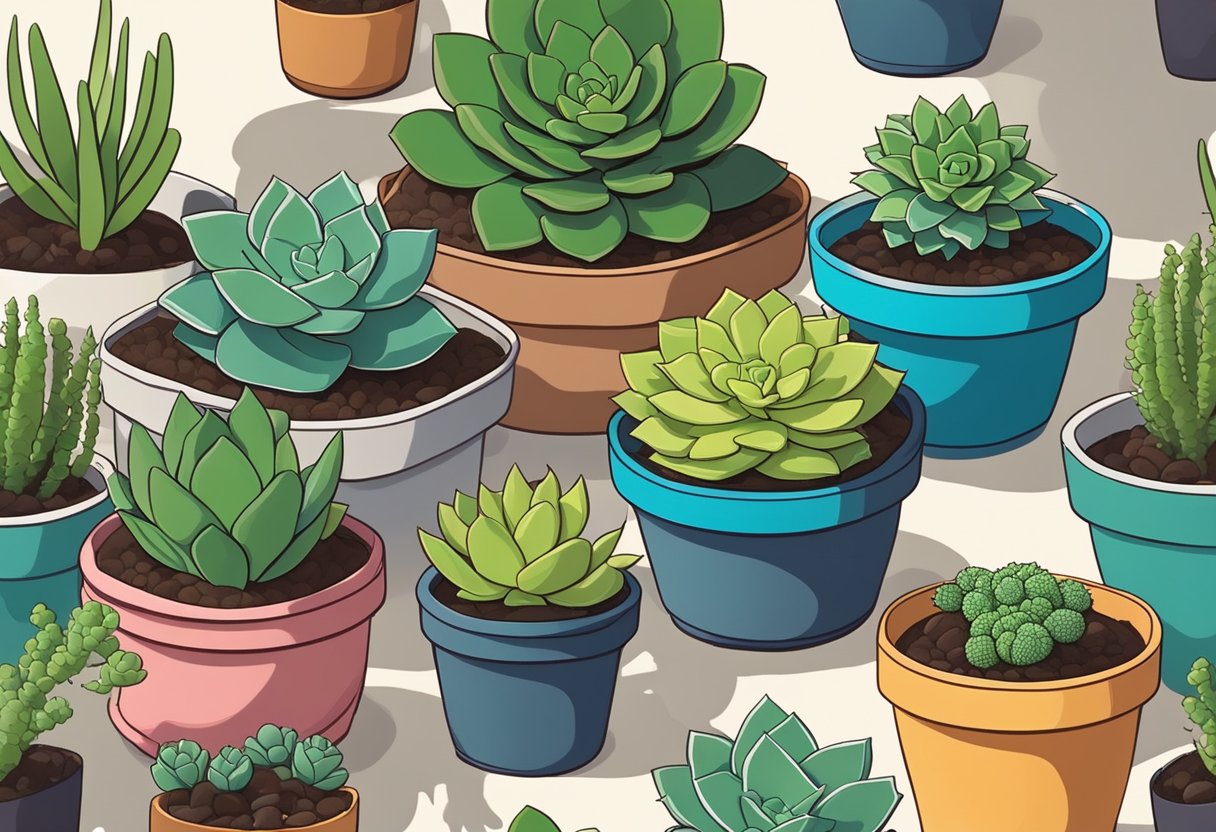
Dealing with Pests
Succulents are generally resistant to pests, but they can still be affected by common houseplant pests such as mealybugs, spider mites, and scale insects. If you notice any signs of pests, it is important to act quickly to prevent them from spreading.
One effective solution is to use a solution of neem oil and water. Simply mix a few drops of neem oil with water and spray the mixture onto the affected areas. This will help to kill the pests and prevent them from coming back.
Another solution is to use a natural insecticide such as diatomaceous earth. This is a powdery substance that can be sprinkled onto the soil and leaves of the plant. It works by dehydrating the pests and killing them.
Addressing Overwatered Succulents
Overwatering is one of the most common issues with succulents. If a succulent is overwatered, it can lead to root rot, which can be fatal to the plant.
To address overwatered succulents, it is important to stop watering the plant immediately. Allow the soil to dry out completely before watering it again. You may also need to repot the plant into fresh, well-draining soil.
To prevent overwatering in the future, make sure to only water the plant when the soil is completely dry. Succulents are adapted to survive in arid conditions and do not require frequent watering.
Fungal Problems
Fungal problems can occur in succulents that are kept in humid or damp conditions. This can lead to diseases such as powdery mildew and root rot.
To prevent fungal problems, it is important to keep the plant in a well-ventilated area with good air circulation. Avoid overwatering the plant and make sure the soil is well-draining.
If you notice any signs of fungal problems, such as white powdery spots on the leaves or a foul odor coming from the soil, it is important to act quickly. Remove any affected leaves or stems and repot the plant into fresh, well-draining soil. You may also need to use a fungicide to treat the plant.
By following these solutions, you can address common issues with succulents and keep your plants healthy and thriving.
Designing with Succulents
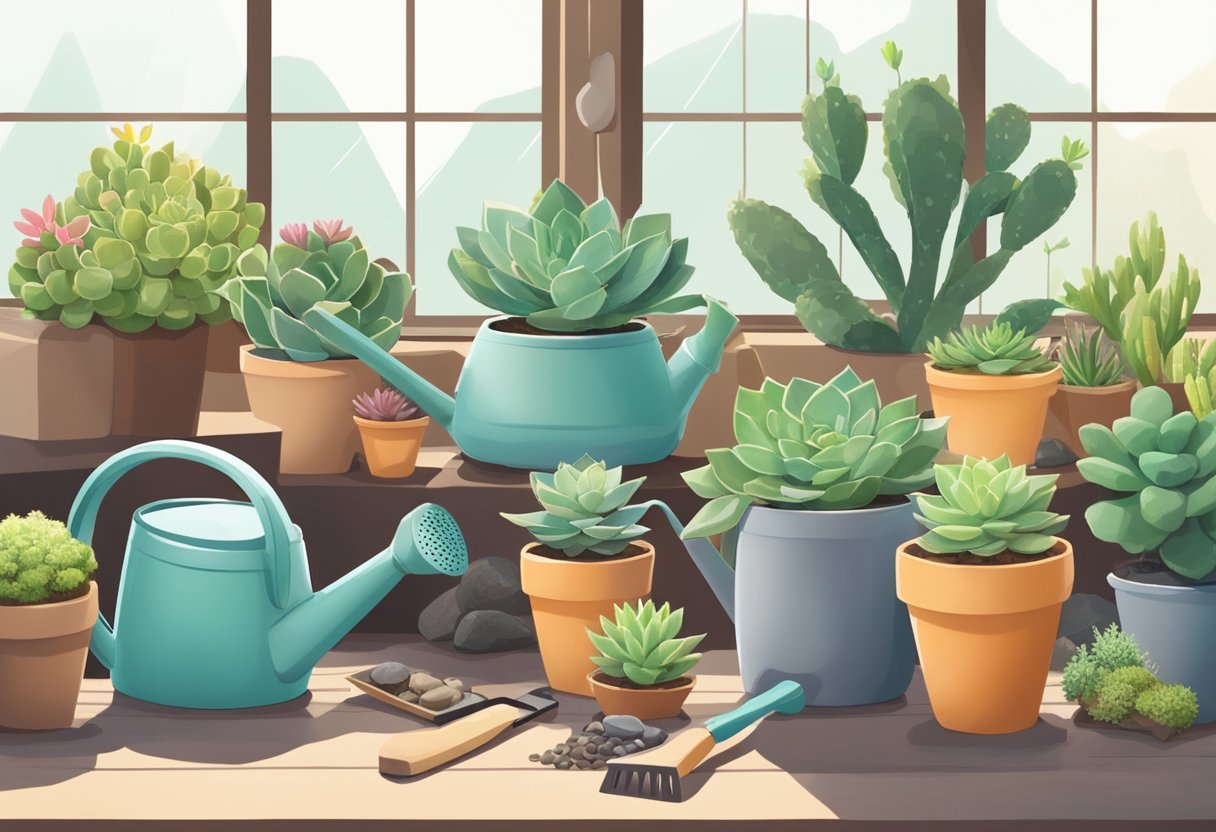
Creating Visual Interest
When it comes to designing with succulents, creating visual interest is key. One way to achieve this is by incorporating a variety of colors and textures. Succulents come in a range of colors including green, blue, purple, and even red. By mixing and matching different colors, you can create a visually stunning display.
Texture is also an important factor to consider. Some succulents have smooth, shiny leaves, while others have a rough, spiky texture. Combining different textures can add depth and interest to your arrangement.
Another way to create visual interest is by using a variety of succulent sizes and shapes. Taller succulents can add height and drama, while smaller ones can fill in gaps and provide contrast.
Succulent Themes and Styles
When designing with succulents, there are a variety of themes and styles to consider. For example, a desert theme can be achieved by using succulents that are native to arid regions. This can include cacti, agave, and yucca plants.
A modern style can be achieved by using sleek, minimalist containers and arranging the succulents in a clean, geometric pattern.
For a more whimsical look, consider using succulents with unusual shapes or colors. Echeveria ‘Lola’ has rosettes of pink and blue, while Crassula ovata ‘Hobbit’ has tubular leaves that resemble fingers.
When choosing a container for your succulents, consider the color and texture of the container as well. A bright, colorful container can add a pop of color to your arrangement, while a rough, textured container can complement the natural texture of the succulents.
To finish off your arrangement, consider using a top dressing. This can be anything from small rocks to sand to decorative moss. A top dressing can add an extra layer of color and texture to your arrangement.
When it comes to soil, it’s important to use a well-draining succulent mix. This will ensure that your succulents don’t become waterlogged and rot.
By considering color, texture, container, and top dressing, you can create a visually stunning succulent arrangement that is sure to impress.
Specialty Succulent Varieties
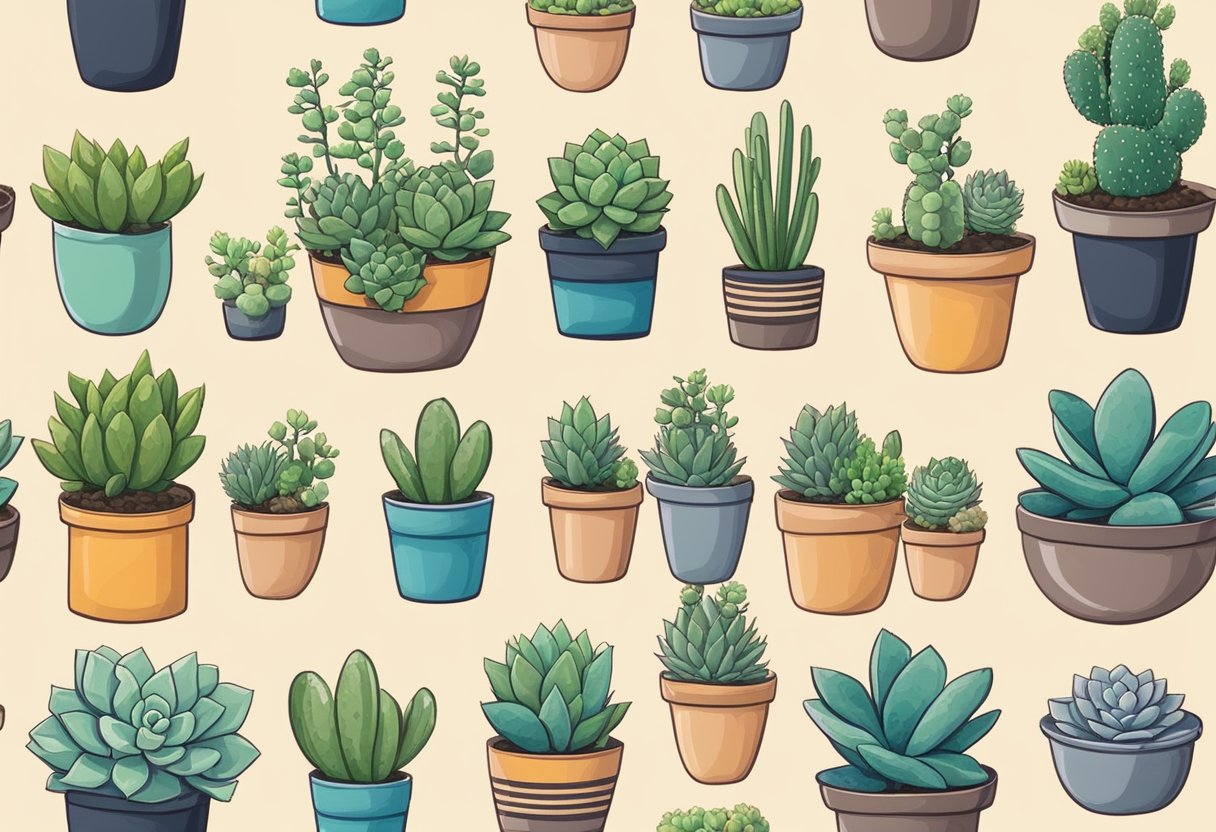
Rare and Exotic Types
Succulent enthusiasts are always on the lookout for rare and exotic varieties to add to their collection. Some of the most sought-after succulents include the Echeveria ‘Raindrops’, String of Pearls ‘Variegata’, and Haworthia ‘Zebra’. These unique succulents can be challenging to find, but they are worth the effort.
The Echeveria ‘Raindrops’ is a stunning succulent with leaves that resemble water droplets. It is a slow-growing plant that requires bright, indirect sunlight and well-draining soil. The String of Pearls ‘Variegata’ is a variegated version of the popular String of Pearls succulent. It has green and white striped leaves and requires bright, indirect sunlight and well-draining soil. The Haworthia ‘Zebra’ is a small succulent with white stripes on its leaves. It is a low-maintenance plant that can thrive in low light conditions.
Succulents for Specific Environments
Different succulent varieties thrive in different environments. Some succulents prefer dry, arid conditions, while others require more humidity. Some of the most popular succulents for specific environments include the Jade Plant, Agave, Aloe, Hens and Chicks, and Living Stones.
The Jade Plant is a hardy succulent that can thrive in a variety of environments. It prefers bright, indirect sunlight and well-draining soil. The Agave is a desert succulent that requires bright, direct sunlight and well-draining soil. The Aloe is a tropical succulent that prefers bright, indirect sunlight and well-draining soil. Hens and Chicks are a group of succulents that form rosettes and can thrive in a variety of environments. They require well-draining soil and can tolerate some shade. Living Stones are small, pebble-like succulents that require bright, indirect sunlight and well-draining soil.
In summary, there are many specialty succulent varieties available for enthusiasts to explore. From rare and exotic types to succulents that thrive in specific environments, there is a succulent for every preference and skill level. By understanding the unique needs of each variety, succulent enthusiasts can create a thriving collection of these beautiful and fascinating plants.
Frequently Asked Questions
What type of soil is best for planting succulents?
Succulents require well-draining soil to prevent root rot. The best soil for planting succulents is a mixture of coarse sand, perlite, and potting soil. This mixture allows for proper drainage while also retaining enough moisture for the plant to thrive.
What are the essential steps for potting succulents indoors?
To pot succulents indoors, start by selecting a pot with drainage holes. Fill the pot with a well-draining soil mixture and make a hole in the center. Carefully remove the succulent from its current pot and gently loosen the roots. Place the succulent in the hole, making sure the roots are covered with soil. Water the plant thoroughly and allow the soil to dry out completely before watering again.
How can succulents be potted in water, and what are the considerations?
Succulents can be propagated in water by placing their cuttings or leaves in a container filled with water. However, it’s important to note that this method is not suitable for long-term growth as succulents need well-draining soil to thrive. Additionally, water propagation can increase the risk of rot and disease.
What are the key design principles for choosing a succulent pot or planter?
When choosing a succulent pot or planter, consider the size and shape of the plant, as well as the aesthetic of the container. The pot should be large enough to accommodate the plant’s root system and have drainage holes to prevent water buildup. Additionally, choose a pot that complements the color and texture of the succulent.
How do you properly plant succulents from cuttings or leaves?
To plant succulents from cuttings or leaves, start by selecting a healthy cutting or leaf. Allow the cutting or leaf to dry out for a few days before planting in a well-draining soil mixture. Water the soil lightly and keep the plant in a warm, bright location. After a few weeks, the cutting or leaf should start to root and grow.
Is it necessary to place rocks at the bottom of a succulent pot for drainage?
Contrary to popular belief, placing rocks at the bottom of a succulent pot does not improve drainage. In fact, this can actually hinder drainage by creating a barrier that prevents water from escaping. Instead, use a well-draining soil mixture and ensure the pot has drainage holes to allow excess water to flow out.

